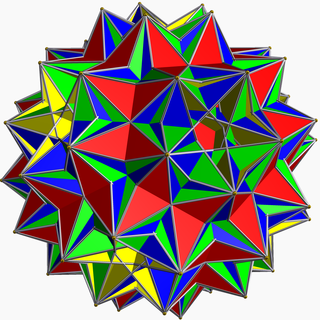
Back Gran dirombidodecàedre dixato Catalan Granda duriproĉa durombo-dekduedro Esperanto Gran dirrombidodecaedro birromo Spanish Grand dirhombidodécaèdre disadouci French 大二重変形二重斜方十二面体 Japanese Marele dirombidodecaedru disnub Romanian Veliki dvojno prirezan dirombidodekaeder Slovenian 大二重扭稜二重斜方十二面體 Chinese
| Great disnub dirhombidodecahedron | |
|---|---|

| |
| Type | Uniform star polyhedron |
| Elements | F = 204, E = 360 V = 60 (χ = −96) |
| Faces by sides | 120{3}+60{4}+24{5/2} |
| Coxeter diagram | {{{Skilling-Coxeter}}} |
| Wythoff symbol | | (3/2) 5/3 (3) 5/2 |
| Symmetry group | Ih, [5,3], *532 |
| Index references | U-, C-, W- |
| Dual polyhedron | Great disnub dirhombidodecacron |
| Vertex figure |  (5/2.4.3.3.3.4. 5/3.4.3/2.3/2.3/2.4)/2 |
| Bowers acronym | Gidisdrid |

In geometry, the great disnub dirhombidodecahedron, also called Skilling's figure, is a degenerate uniform star polyhedron.
It was proven in 1970 that there are only 75 uniform polyhedra other than the infinite families of prisms and antiprisms. John Skilling discovered another degenerate example, the great disnub dirhombidodecahedron, by relaxing the condition that edges must be single. More precisely, he allowed any even number of faces to meet at each edge, as long as the set of faces couldn't be separated into two connected sets (Skilling, 1975). Due to its geometric realization having some double edges where 4 faces meet, it is considered a degenerate uniform polyhedron but not strictly a uniform polyhedron.
The number of edges is ambiguous, because the underlying abstract polyhedron has 360 edges, but 120 pairs of these have the same image in the geometric realization, so that the geometric realization has 120 single edges and 120 double edges where 4 faces meet, for a total of 240 edges. The Euler characteristic of the abstract polyhedron is −96. If the pairs of coinciding edges in the geometric realization are considered to be single edges, then it has only 240 edges and Euler characteristic 24.
The vertex figure has 4 square faces passing through the center of the model.
It may be constructed as the exclusive or (blend) of the great dirhombicosidodecahedron and compound of twenty octahedra.